- Главная
- Разное
- Бизнес и предпринимательство
- Образование
- Развлечения
- Государство
- Спорт
- Графика
- Культурология
- Еда и кулинария
- Лингвистика
- Религиоведение
- Черчение
- Физкультура
- ИЗО
- Психология
- Социология
- Английский язык
- Астрономия
- Алгебра
- Биология
- География
- Геометрия
- Детские презентации
- Информатика
- История
- Литература
- Маркетинг
- Математика
- Медицина
- Менеджмент
- Музыка
- МХК
- Немецкий язык
- ОБЖ
- Обществознание
- Окружающий мир
- Педагогика
- Русский язык
- Технология
- Физика
- Философия
- Химия
- Шаблоны, картинки для презентаций
- Экология
- Экономика
- Юриспруденция
Что такое findslide.org?
FindSlide.org - это сайт презентаций, докладов, шаблонов в формате PowerPoint.
Обратная связь
Email: Нажмите что бы посмотреть
Презентация на тему Phonetic Styles
Содержание
- 2. Contents1. Phonetic peculiarities of style2. Style-forming and style-modifying factors3. Classifying phonetic styles
- 3. Phonetic peculiarities of styleWhen used in speech
- 4. PhonostylisticsPhonostylistics is a branch of phonetics which
- 5. The extralinguistic situationThe extralinguistic situation can be
- 6. The scene (setting)The scene (setting) includes the
- 7. Style-forming and style-modifying factorsThe extralinguistic factors, that
- 8. The aim of communicationThe purpose, or aim
- 9. Factors of stylistic variations of sounds and
- 10. Segmental and prosodic style-forming meansEach style of
- 11. Formal and informal situationsIn formal situations pronunciation
- 12. Classifying phonetic stylesAll existing classifications are based
- 13. The classification based on the purpose of
- 14. Classification by S. Gaiduchik There now appear
- 15. Скачать презентацию
- 16. Похожие презентации
Contents1. Phonetic peculiarities of style2. Style-forming and style-modifying factors3. Classifying phonetic styles


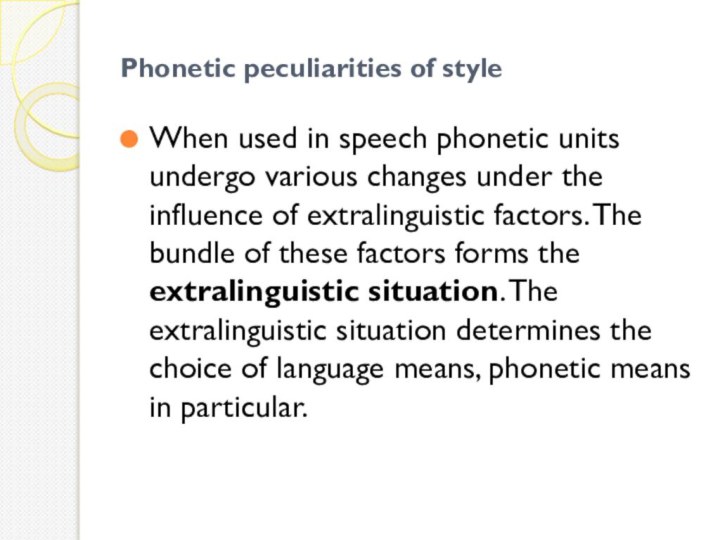
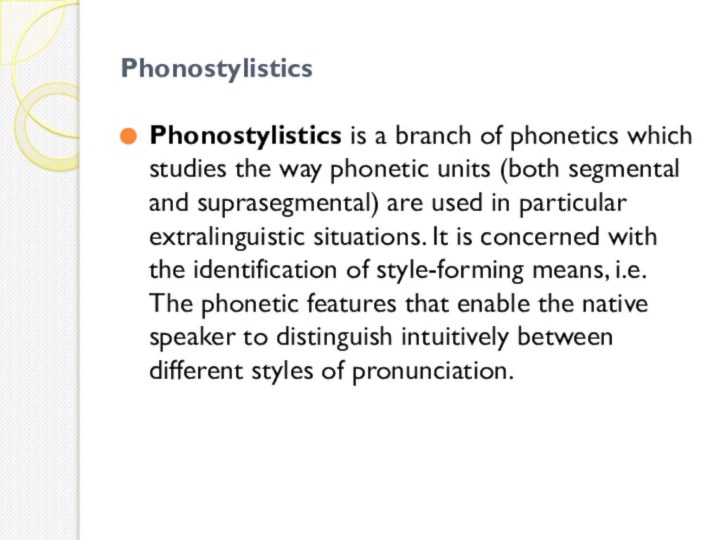
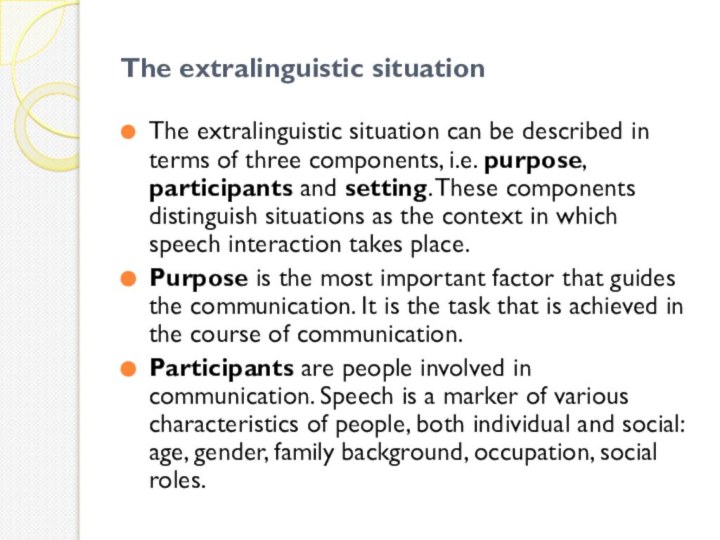
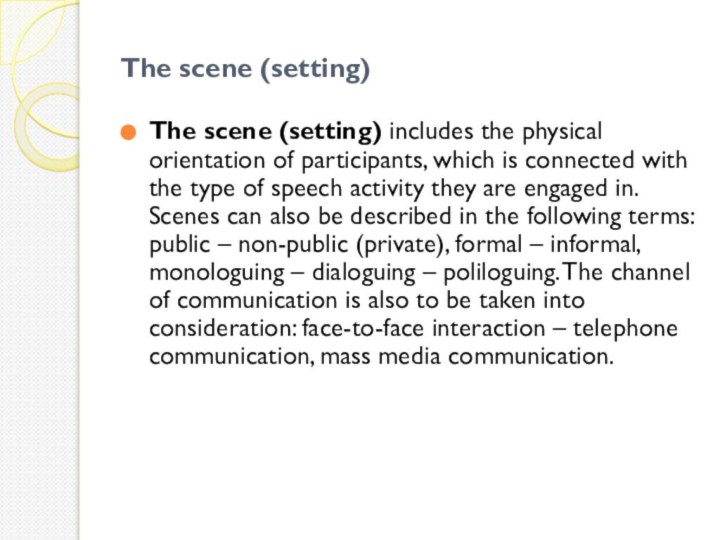
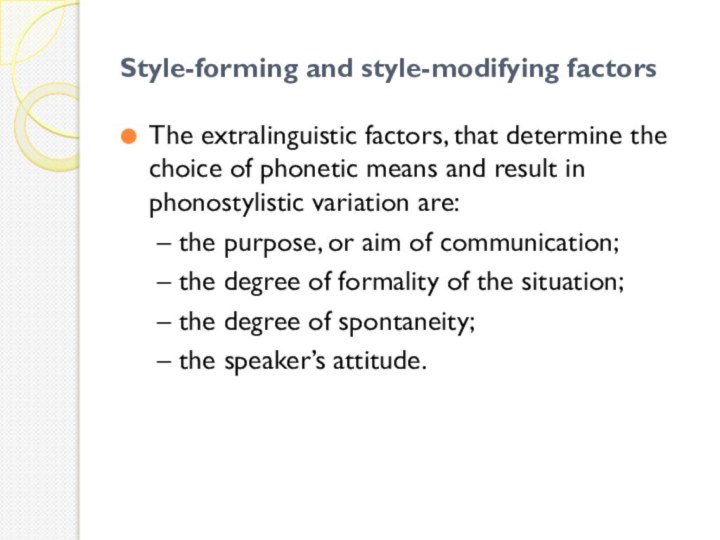
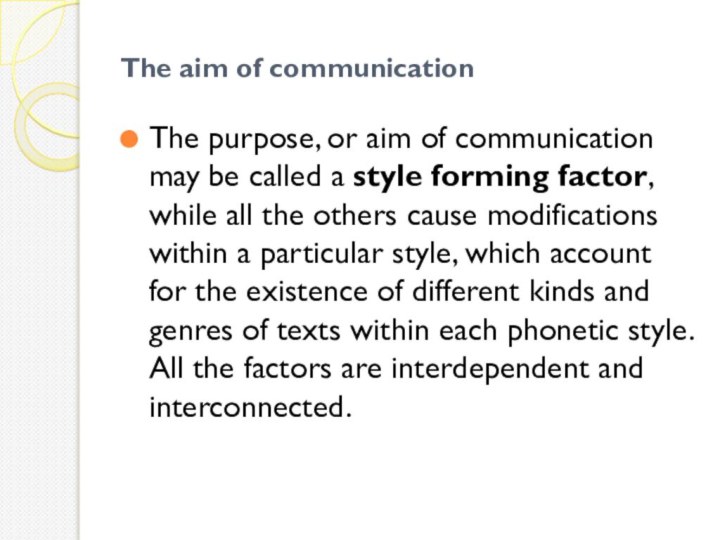
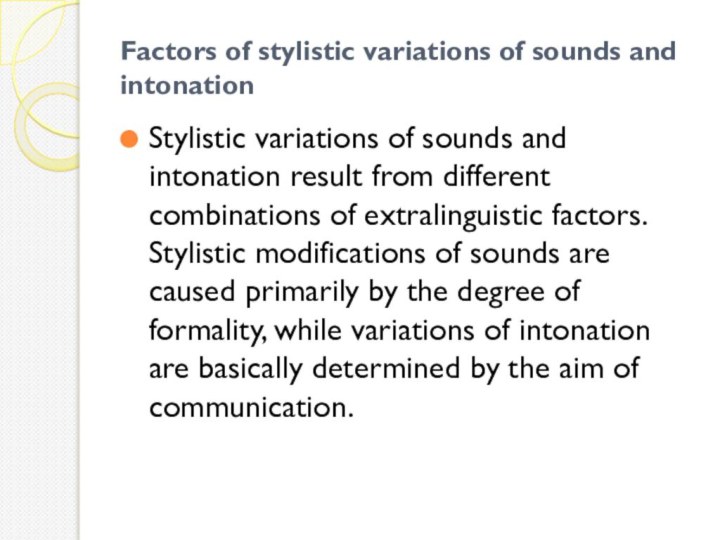
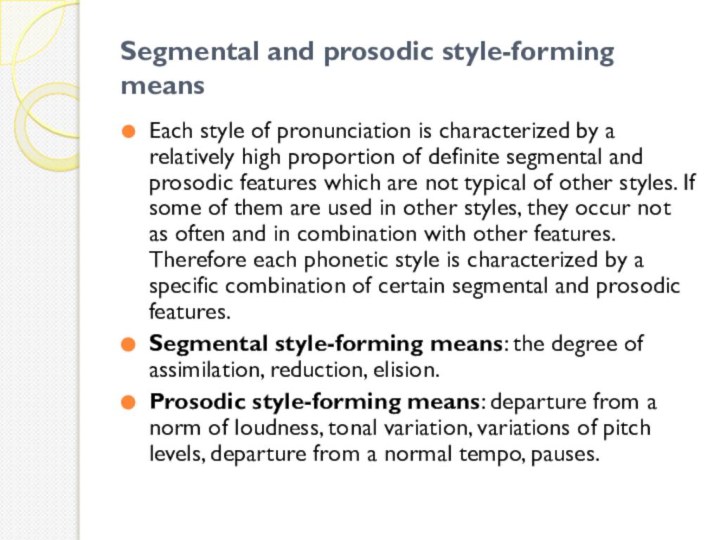
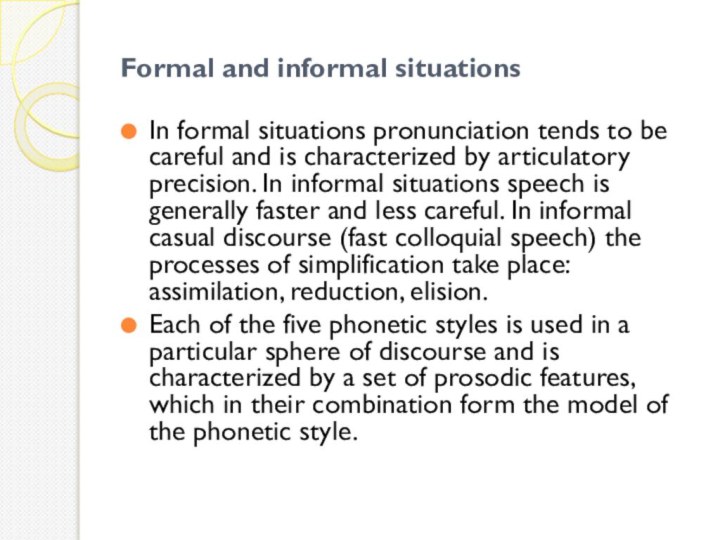
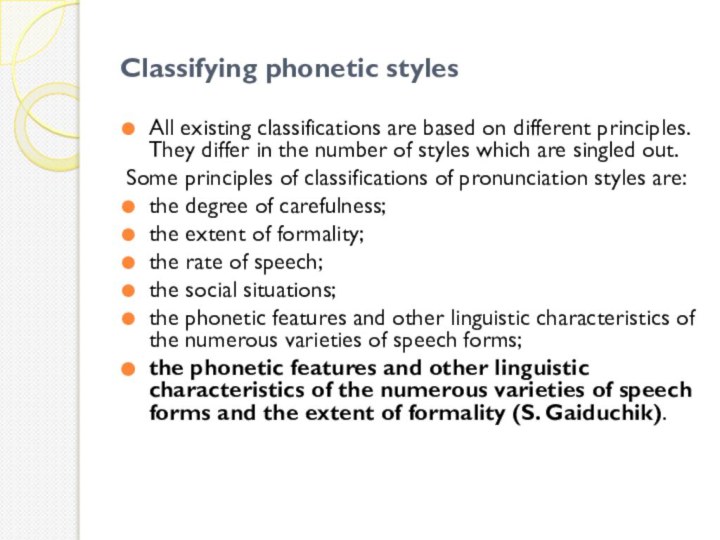

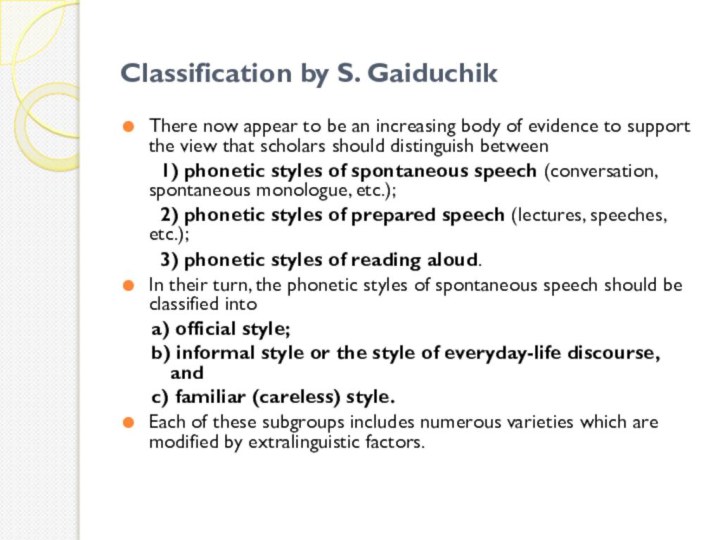
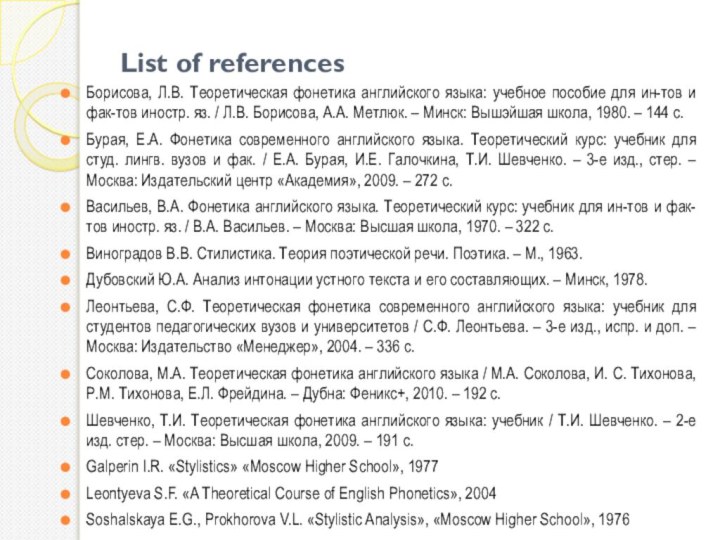
Слайд 3
Phonetic peculiarities of style
When used in speech phonetic
units undergo various changes under the influence of extralinguistic
factors. The bundle of these factors forms the extralinguistic situation. The extralinguistic situation determines the choice of language means, phonetic means in particular.
Слайд 4
Phonostylistics
Phonostylistics is a branch of phonetics which studies
the way phonetic units (both segmental and suprasegmental) are
used in particular extralinguistic situations. It is concerned with the identification of style-forming means, i.e. The phonetic features that enable the native speaker to distinguish intuitively between different styles of pronunciation.
Слайд 5
The extralinguistic situation
The extralinguistic situation can be described
in terms of three components, i.e. purpose, participants and
setting. These components distinguish situations as the context in which speech interaction takes place.Purpose is the most important factor that guides the communication. It is the task that is achieved in the course of communication.
Participants are people involved in communication. Speech is a marker of various characteristics of people, both individual and social: age, gender, family background, occupation, social roles.
Слайд 6
The scene (setting)
The scene (setting) includes the physical
orientation of participants, which is connected with the type
of speech activity they are engaged in. Scenes can also be described in the following terms: public – non-public (private), formal – informal, monologuing – dialoguing – poliloguing. The channel of communication is also to be taken into consideration: face-to-face interaction – telephone communication, mass media communication.
Слайд 7
Style-forming and style-modifying factors
The extralinguistic factors, that determine
the choice of phonetic means and result in phonostylistic
variation are:– the purpose, or aim of communication;
– the degree of formality of the situation;
– the degree of spontaneity;
– the speaker’s attitude.
Слайд 8
The aim of communication
The purpose, or aim of
communication may be called a style forming factor, while
all the others cause modifications within a particular style, which account for the existence of different kinds and genres of texts within each phonetic style. All the factors are interdependent and interconnected.
Слайд 9
Factors of stylistic variations of sounds and intonation
Stylistic
variations of sounds and intonation result from different combinations
of extralinguistic factors. Stylistic modifications of sounds are caused primarily by the degree of formality, while variations of intonation are basically determined by the aim of communication.
Слайд 10
Segmental and prosodic style-forming means
Each style of pronunciation
is characterized by a relatively high proportion of definite
segmental and prosodic features which are not typical of other styles. If some of them are used in other styles, they occur not as often and in combination with other features. Therefore each phonetic style is characterized by a specific combination of certain segmental and prosodic features.Segmental style-forming means: the degree of assimilation, reduction, elision.
Prosodic style-forming means: departure from a norm of loudness, tonal variation, variations of pitch levels, departure from a normal tempo, pauses.
Слайд 11
Formal and informal situations
In formal situations pronunciation tends
to be careful and is characterized by articulatory precision.
In informal situations speech is generally faster and less careful. In informal casual discourse (fast colloquial speech) the processes of simplification take place: assimilation, reduction, elision.Each of the five phonetic styles is used in a particular sphere of discourse and is characterized by a set of prosodic features, which in their combination form the model of the phonetic style.
Слайд 12
Classifying phonetic styles
All existing classifications are based on
different principles. They differ in the number of styles
which are singled out.Some principles of classifications of pronunciation styles are:
the degree of carefulness;
the extent of formality;
the rate of speech;
the social situations;
the phonetic features and other linguistic characteristics of the numerous varieties of speech forms;
the phonetic features and other linguistic characteristics of the numerous varieties of speech forms and the extent of formality (S. Gaiduchik).
Слайд 13
The classification based on the purpose of communication
The
classification of phonetic styles is based on the purpose
of communication, which is the most significant extralinguistic factor. Five phonetic styles can be singled out according to the purpose of communication:1. Informational style;
2. Academic (Scientific) style;
3. Publicistic (Oratorial) style;
4. Declamatory (Artistic) style;
5. Conversational (Familiar) style.
Слайд 14
Classification by S. Gaiduchik
There now appear to
be an increasing body of evidence to support the
view that scholars should distinguish between1) phonetic styles of spontaneous speech (conversation, spontaneous monologue, etc.);
2) phonetic styles of prepared speech (lectures, speeches, etc.);
3) phonetic styles of reading aloud.
In their turn, the phonetic styles of spontaneous speech should be classified into
a) official style;
b) informal style or the style of everyday-life discourse, and
c) familiar (careless) style.
Each of these subgroups includes numerous varieties which are modified by extralinguistic factors.





























